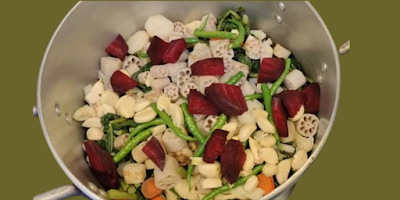Kashmiri Achar | Kashur Anchar | Mixed Vegetable Pickle
Kashmiri Achar :Kashmiri Mixed Vegetable Pickle
Today, we will learn how to make authentic Kashmiri anchar (pickle), commonly known as Kashur Anchar. This is a recipe that I'm sure everyone will love. Kashmiri anchar made at home is preferred by many because it is prepared in a clean and hygienic manner. Give it a try, and then provide us with your feedback.
Kashmiri Achar | Koshur Anchar | Kashmiri Pickle:
Kashmiri achar, or anchar, is a traditional pickle from the Kashmir region known for its unique blend of flavors.Made from a medley of vegetables like lotus stem, cauliflower, and carrots, the achar undergoes a meticulous preparation process, including blanching, drying, and spicing. The distinctive taste is achieved through a mix of mustard oil, coriander, cumin, and other aromatic spices. Vinegar or lemon juice adds a tangy kick, enhancing the overall profile. Stored in airtight containers, the achar ferments over weeks, preserving its authenticity. Enjoyed with various dishes, Kashmiri achar stands out for its burst of Kashmiri culinary essence.
Ingredients:
- Kashmiri saagh(haakh)/green collard: 1kg
- Cauliflower/phoolgobi: 1
- Nadru/lotus stem: 5-6 sticks
- Beetroot/chukandar: 1
- Radish/mooli: 3-4
- Carrots/gajar: 10 (a bunch)
- Mustard oil
- Dhaniwal seeds/coriander seeds: 1 cup
- Black mustard seeds (Kashmir name - Aasur): 1/2 cup
- Carrom seeds (ajwain) (Kashmiri name: jaavain): 3 tbsp
- Jeera/cumin: 1 tbsp
- Garlic cloves: 15-20
- Green chillies: 10-12
- Coriander powder: 1 tbsp
- Ginger powder: 1/2 tbsp
- Turmeric powder: 1 tbsp
- Red chilli powder: 3-4 tbsp
- Salt (according to taste)
- Vinegar: 2 tbsp
How To Make Kashmiri Achar / Kashur Anchar :
Step-By-Step Guide
1. Preparation of Vegetables:*
- Cut all vegetables into small pieces. Cut Kashmiri saag into small pieces, cauliflower into small florets, slice carrots, and cut beetroot at the end after peeling,and other veggies into bite-sized pieces.Keep all the vegetables aside.
2. Blanching Process:
Blanching is a crucial step to ensure the vegetables are clean and ready for preservation.This process eliminates bacteria, dirt, and any pests present in the vegetables. Follow these steps:
- Blanch the lotus stem (nadru) separately.Boil it in water and then transfer to cold water to stop cooking and remove impurities.
- Blanch the remaining vegetables ,boil water again(carrots, mooli, phoolgobi) in boiling water and transfer them to cold water to stop the cooking process.
- Blanch the saagh in the same manner.
3. Salting and Drying:
- Sprinkle salt over all the blanched vegetables to remove excess water. Rub the salt to cover each piece.Ensure each piece is coated with salt. Add about 2-3 teaspoons of salt, depending on the quantity of vegetables, and rub it thoroughly
-Do the same for the lotus stem but keep it separate for now.
- Now, we need to let these vegetables dry. If there's too much sunlight, you can dry them for 12 hours. Otherwise, in less sunlight, like during winters, you can dry them indoors. Place a sheet at the bottom and spread the vegetables on top. Let them dry for at least 24 hours, ensuring that all excess water evaporates.
4. Spice Preparation:
Mustard oil is always used in Kashmiri pickles for better preservation. Heat the mustard oil until it starts smoking, let it cool down, and then use it.
- In another pan, roast coriander seeds (dhaniwal seeds) and black mustard seeds (Aasur) - 1 cup and 1/2 cup, respectively.Roast them lightly; they shouldn't burn. Add 1 tablespoon of cumin (jeera) and roast it along with the other seeds.
- After roasting, lightly crush the coriander and black mustard seeds together. You can use a mixer grinder for this, but ensure that it's coarsely ground, not powdered.
-And carrom seeds (ajwain) (Kashmiri name: jaavain) 3 tbsp, but we are not roasting the ajwain/jaavain.
- Take 15-20 garlic cloves and crush them slightly.
5. Mixing the Vegetables and Spices:
- In a large container, mix the dried vegetables with 10-12 Green chillies, crushed Garlic, and sliced Beetroot.
- Add the roasted and crushed spices,1 tablespoon of Coriander powder,1/2 tablespoon of Ginger powder .Also, add the unroasted Ajwain. Mix them well.Add1 tablespoon of Turmeric powder, 3-4 tablespoons of Red chili powder (adjust according to taste), and Salt. Mix well.
6. Adding Mustard Oil & Vinegar:
- Add the cooled mustard oil, mix it gradually, and ensure that it coats all the vegetables evenly.
- Finally, add 2 tablespoons of vinegar for a tangy flavor and to aid in the fermentation process. Adjust the quantity based on your taste preferences. If you don't have vinegar, you can use lemon juice.
7.Bottling and Preserving:
After the specified duration, you'll have a delicious Kashmiri pickle ready to be enjoyed.
FAQs
Q1: Can I use any other oil besides mustard oil?
A1: Mustard oil is traditionally used for its preserving properties, but you can experiment with other oils.
Q2 :How long does the homemade anchar last?
A2: If preserved properly, it can last for several months. Ensure the container is airtight.
Q3: Can I adjust the spice levels in the recipe?
A3: Absolutely! Feel free to customize the spice levels according to your taste preferences.
Q4: Is it necessary to use Kashmiri saagh for this recipe?
A4: While Kashmiri saagh adds authenticity, you can substitute with other greens if needed.
Q5: Can I use lemon juice instead of vinegar?
A5: Yes, you can use lemon juice as an alternative for a slightly different flavor.


































.jpg)
.jpg)
.jpg)
Post a Comment